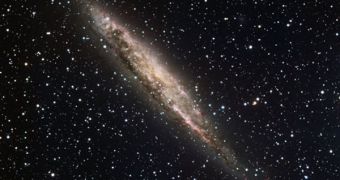A new, high-detail telescope image has recently revealed one of our galactic neighbors, situated relatively nearby, which mimics the Milky Way in more ways than one. The spiraled giant has been dubbed NGC 4945, following astronomers' habit of terming all cosmic objects with catchy names. In the recent photograph, the galaxy can be seen edge-on, so it's really difficult to tell precisely what size it has. Experts, however, know from previous studies that it also has spiral arms, and a bar-like structure at its center, which makes it remarkably similar to our own corner of the Universe.
But the two also differ considerably, especially when it comes to their central regions. While the Milky Way is powered by a fairly large and massive black hole, a supermassive black hole lurks at the center of NGC 4945, consuming enormous amounts of matter, and spewing dangerous radiation in space from its highly active poles. The structure is located within the constellation of Centaurus, which is some 13 million light-years away from the Earth, Space reports.
The recent image was collected with the Wide Field Imager (WFI) instrument, which is located on the 2.2-meter MPG telescope, at the La Silla Observatory, in Chile. The entire ensemble is operated by the European Southern Observatory, which also has a number of other outposts in the country. The detailed photo revealed the fact that the distant galaxy was also similar to the Milky Way as far as its general structure was concerned. Its disk is relatively flat for the most part, but it bulges around the center, where millions and millions of stars surround the black hole.
The recent scientific investigations also revealed that the nucleus of NGC 4945 was highly active, which means that it produces and spreads a lot more energy and radiation than galaxies such as the Milky Way, which, in spite of its size, is considered to be relatively calm. Due to the numerous filters that were used for the recent image, the science team behind the observations was also able to detect a number of areas showing intense signs of star formation – stellar nurseries.

 14 DAY TRIAL //
14 DAY TRIAL //